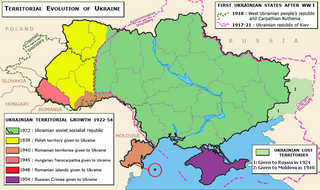 W
WUkraine emerges as the concept of a nation, and the Ukrainians as a nationality, with the Ukrainian National Revival which is believed started sometime at the end of 18th and the beginning of 19th century. According to Ukrainian historian Yaroslav Hrytsak, the first wave of national revival is traditionally connected with publication of the first part of "Eneyida" by Ivan Kotlyarevsky (1798). In 1846, in Moscow the "Istoriya Rusov ili Maloi Rossii" was published. During the Spring of Nations, in 1848 in Lemberg (Lviv)the Supreme Ruthenian Council was created which declared that Galician Ruthenians are part of the bigger Ukrainian nation. The council adopted the yellow and blue flag.
 W
WThe Crimean Peninsula, north of the Black Sea in Eastern Europe, was annexed by the Russian Federation between February and March 2014 and since then has been administered as two Russian federal subjects—the Republic of Crimea and the federal city of Sevastopol. The annexation from Ukraine followed a Russian military intervention in Crimea that took place in the aftermath of the 2014 Ukrainian revolution and was part of wider unrest across southern and eastern Ukraine.
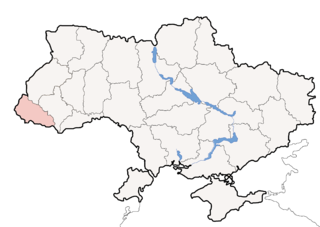 W
WCarpathian Ruthenia, Carpatho-Ukraine or Zakarpattia is a historic region in the border between Central and Eastern Europe, mostly located in western Ukraine's Zakarpattia Oblast, with smaller parts in easternmost Slovakia and Lemkivshchyna in Poland. In the Middle Ages it was part of Kievan Rus. Before World War I most of this region was part of the Kingdom of Hungary. In the interwar period, it was part of the First and Second Czechoslovak Republic. During World War II, the region was annexed by the Kingdom of Hungary once again. After the war, it was occupied by the USSR and became part of Soviet Ukraine.
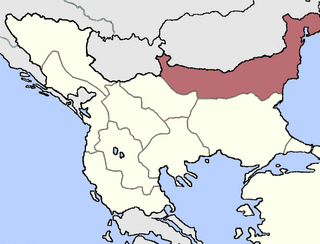 W
WThe Vilayet of the Danube or Danubian Vilayet was a first-level administrative division (vilayet) of the Ottoman Empire from 1864 to 1878. In the late 19th century it reportedly had an area of 34,120 square miles (88,400 km2).
 W
WEuromaidan was a wave of demonstrations and civil unrest in Ukraine, which began on the night of 21 November 2013 with public protests in Maidan Nezalezhnosti in Kyiv. The protests were sparked by the Ukrainian government's decision to suspend the signing of an association agreement with the European Union, instead choosing closer ties to Russia and the Eurasian Economic Union. The scope of the protests soon widened, with calls for the resignation of President Viktor Yanukovych and his government. The protests were fueled by the perception of "widespread government corruption", "abuse of power", and "violation of human rights in Ukraine". Transparency International named President Yanukovych as the top example of corruption in the world. The situation escalated after the violent dispersal of protesters on 30 November, leading to many more protesters joining. The protests led to the 2014 Ukrainian revolution.
 W
WThe Orange Revolution was a series of protests and political events that took place in Ukraine from late November 2004 to January 2005, in the immediate aftermath of the run-off vote of the 2004 Ukrainian presidential election, which was claimed to be marred by massive corruption, voter intimidation and electoral fraud. Kyiv, the Ukrainian capital, was the focal point of the movement's campaign of civil resistance, with thousands of protesters demonstrating daily. Nationwide, the revolution was highlighted by a series of acts of civil disobedience, sit-ins, and general strikes organized by the opposition movement.
 W
WThe Revolution of Dignity, also known as the Euromaidan revolution or 2014 Ukrainian revolution, took place in Ukraine in February 2014, when a series of violent events involving protesters, riot police, and unknown shooters in the capital, Kyiv, culminated in the ousting of the elected Ukrainian President, Viktor Yanukovych, and the overthrow of the Ukrainian Government.
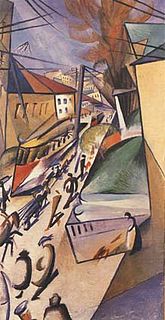 W
WUkrainian avant-garde is a term widely used to refer the most innovative metamorphosises in Ukrainian art from the end of 1900s to the middle of the 1930s along with associated artists. Broadly speaking, it is Ukrainian art synchronized with the international avant-garde in sculpture, painting, literature, cinema, theater, stage design, graphics, music, architecture. Some Ukrainian avant-garde artists who are fairly well-known include Kazimir Malevich, Alexander Archipenko, Vladimir Tatlin, Sonia Delaunay, Vasyl Yermylov, Alexander Bogomazov, Aleksandra Ekster, David Burliuk, Vadym Meller, Anatol Petrytsky all of them were closely connected to Ukrainian cities Kyiv, Kharkiv, Lviv, Odessa by birth, education, language, national traditions or identity. One of the earliest uses of the term "Ukrainian Avant-Garde" concerning painting and sculpture during Soviet censorship was in the artistic discussion at Tatlin's dream exhibition, curated by Parisian art historian Andréi Nakov, in London, 1973, which showcased works of Ukrainian artists Vasyl Yermylov and Alexander Bogomazov. The first international avant-garde exhibitions in Ukraine which included French, Italian, Ukrainian and Russian artists took place in Odessa and Kyiv at the Izdebsky Salon; later the pieces were shown in St. Petersburg and Riga. The cover of "Izdebsky Salon 2" (1910–11) contained abstract work by Wassily Kandinsky.
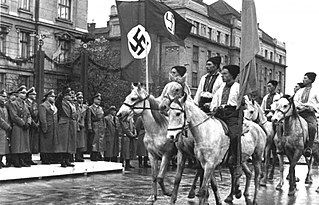 W
WCollaboration with Nazi Germany in German-occupied Ukraine took place during the military occupation of what is now Ukraine by Nazi Germany in World War II. The new territorial divisions included Distrikt Galizien and Reichskommissariat Ukraine, which covered both, the south-eastern territories of the Second Polish Republic and the Ukrainian Soviet Socialist Republic, across the former borders.
 W
WThe Ukrainian national government of 1941 was a self-proclaimed Ukrainian government established on the Ukrainian territories occupied by Nazi Germany. The government was established by the 30 June 1941 Act of restoration of the Ukrainian state. It was led by the Stepan Bandera's faction of OUN.
 W
WThe Ukrainian Insurgent Army was a Ukrainian nationalist paramilitary and later partisan formation. During World War II, it was engaged in guerrilla warfare against the Soviet Union, the Polish Underground State, Communist Poland and Nazi Germany. It was established by the Organization of Ukrainian Nationalists. The insurgent army arose out of separate militant formations of the Organization of Ukrainian Nationalists—Bandera faction, other militant national-patriotic formations, some former defectors of the Ukrainian Auxiliary Police, mobilization of local populations and others. The political leadership of the army belonged to the Organization of Ukrainian Nationalists—Bandera. It was the primary perpetrator of the ethnic cleansing of Poles in Volhynia and Eastern Galicia.
 W
WThe Ukrainian People's Republic (UPR), or Ukrainian National Republic (UNR), was declared in Ukraine following the February Revolution in Russia. It initially formed part of the Russian Republic, and proclaimed its independence from the Russian Soviet Republic on 25 January 1918. During its short existence the republic went through several political transformations - from the socialist-leaning republic headed by the Central Council with its general secretariat to the national republic led by the Directorate and by Symon Petliura. Between April and December 1918 the Ukrainian People's Republic did not function, having been overthrown by the pro-German Ukrainian State of Pavlo Skoropadsky, who proclaimed himself Hetman. From late 1919 the UNR operated as an ally of the Second Polish Republic, but by then the state de facto no longer existed in Ukraine. The 18 March 1921 Treaty of Riga between the Second Polish Republic, Soviet Russia and of Soviet Ukraine sealed the fate of the Ukrainian People's Republic.
 W
WThe Ukrainian People's Republic of Soviets (1917–1918) was a short-lived Soviet republic of the Russian SFSR that was created by the declaration of the Kharkiv All-Ukrainian Congress of Soviets "About the self-determination of Ukraine" on 25 December [O.S. 12 December] 1917 in the Noble Assembly building in Kharkiv. The republic was later united into the Ukrainian Soviet Republic and, eventually, liquidated, because of a cessation of support from the government of the Russian SFSR when the Treaty of Brest-Litovsk was signed.
 W
WThe Ukrainian Soviet Socialist Republic, also known as Soviet Ukraine, was one of the constituent republics of the Soviet Union from the Union's inception in 1922 to its breakup in 1991. In anthem of the Ukrainian Soviet Socialist Republic, the republic was referred to simply as Ukraine. The republic was governed by the Communist Party of the Soviet Union out of Moscow through its republican branch the Communist Party of Ukraine as a union republic of the Soviet Union, which existed as a one-party state. All members of the Central Committee of the Communist Party of Ukraine were members of the Communist Party of the Soviet Union without exceptions.
 W
WUkrainian underground is movement in soviet period of Ukraine, from the late 1950s until the early 1990s. This art form was banned by several totalitarian countries of Eastern Europe and the USSR. It was also known under other names, such as Unofficial art, Nonconformism, and Dissident art. It ended due to the Perestroika reform movement, which lead to Ukrainian independence in 1991. After the Soviet Union collapsed, similar counter-cultural processes developed under the names of "alternative" or "marginal" art.
 W
WThe Ukrainian War of Independence, a period of sustained warlike conflict, lasted from 1917 to 1921 and resulted in the establishment and development of a Ukrainian republic, most of which was later absorbed into the Soviet Union as the Ukrainian Soviet Socialist Republic of 1922–1991.
 W
WUkraine is a country in Eastern Europe. It is bordered by Russia to the east and north-east; Belarus to the north; Poland, Slovakia and Hungary to the west; and Romania, Moldova, Crimea, and the Black Sea to the south. Including Crimea, Ukraine has an area of 603,628 km2 (233,062 sq mi), and is the second-largest country in Europe after Russia. Excluding Crimea, Ukraine has a population of about 42 million, making it the eighth-most populous country in Europe. Its capital and largest city is Kyiv.